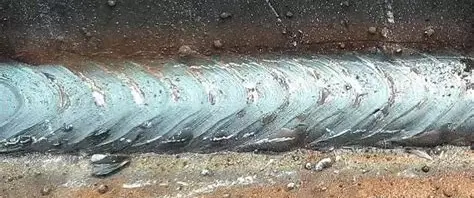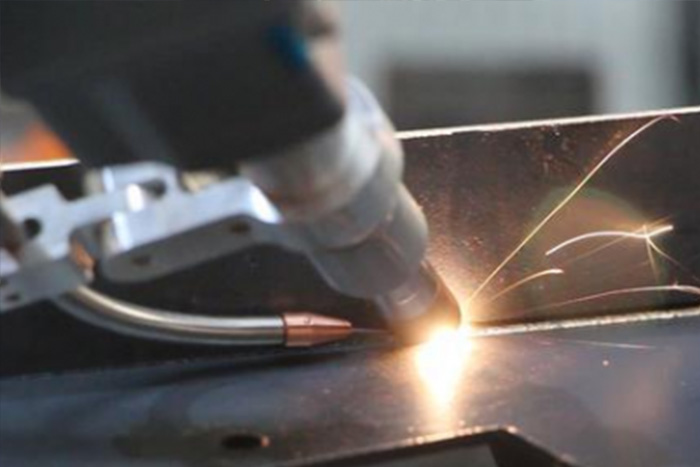Porosity in laser welding is a critical defect defined as gas-filled voids trapped within the solidified weld metal. It directly compromises mechanical integrity, weld strength, and fatigue life. This guide provides a direct, solutions-first approach, incorporating findings from the latest research in advanced beam shaping and AI-driven process control to outline the most effective mitigation strategies.
Analysis of Porosity: Causes and Effects
Porosity is not a single-mechanism defect; it originates from several distinct physical and chemical phenomena during the rapid welding process. Understanding these root causes is essential for effective prevention.
Primary Causes
Surface Contamination: This is the most frequent source of metallurgical porosity. Contaminants like moisture, oils, and greases are rich in hydrogen. Under the intense energy of the laser, these compounds decompose, injecting elemental hydrogen into the molten metal. As the weld pool cools and solidifies rapidly, the solubility of hydrogen plummets, forcing it out of solution to form fine, spherical pores.
Keyhole Instability: This is the main driver of process porosity. A stable keyhole is essential for a sound weld. If process parameters are not optimized (e.g., welding speed is too high for the laser power), the keyhole can fluctuate, become unstable, and momentarily collapse. Each collapse traps a pocket of the high-pressure metal vapor and shielding gas within the molten pool, resulting in large, irregularly shaped voids.
Inadequate Gas Shielding: The purpose of shielding gas is to displace the surrounding atmosphere. If the flow is insufficient, or if excessive flow causes turbulence that draws in air, atmospheric gases—primarily nitrogen and oxygen—will contaminate the weld. Oxygen readily forms solid oxides within the melt, while nitrogen can be trapped as pores or form brittle nitride compounds, both of which compromise the weld’s integrity.
Detrimental Effects
Reduced Mechanical Properties: Pores reduce the load-bearing cross-sectional area of the weld, directly lowering its Ultimate Tensile Strength. More critically, they act as internal voids that prevent the uniform plastic deformation of the metal under load. This loss of material continuity significantly reduces ductility, making the weld more brittle and prone to sudden fracture.
Compromised Fatigue Life: This is often the most critical consequence. Pores, especially those with sharp corners, are powerful stress concentrators. When a component is subjected to cyclic loading, the stress at the edge of a pore can be many times higher than the overall stress in the part. This localized high stress initiates micro-cracks that grow with each cycle, leading to fatigue failure far below the material’s rated static strength.
Increased Corrosion Susceptibility: When a pore breaks the surface, it creates a site for crevice corrosion. The tiny, stagnant environment inside the pore has a different chemical makeup than the surrounding surface. This difference creates an electrochemical cell that aggressively accelerates localized corrosion.
Creation of Leak Paths: For components that require a hermetic seal—such as battery enclosures or vacuum chambers—porosity is an immediate failure condition. A single pore that extends from the inner to the outer surface creates a direct path for liquids or gases to leak, rendering the component useless.
Actionable Mitigation Strategies to Eliminate Porosity
1. Foundational Process Controls
Meticulous Surface Preparation
This is the leading cause of porosity. All surfaces and filler materials must be thoroughly cleaned immediately prior to welding.
Solvent Cleaning: Use a solvent like acetone or isopropyl alcohol to thoroughly clean all weld surfaces. This is a critical step because hydrocarbon contaminants (oils, grease, cutting fluids) decompose under the laser’s intense heat, injecting hydrogen directly into the molten weld pool. As the metal rapidly solidifies, this trapped gas creates fine porosity that degrades weld strength. The solvent works by dissolving these compounds, allowing them to be wiped away completely before welding.
Caution: Avoid chlorinated solvents, as their residue can decompose into hazardous gases and cause embrittlement.
Mechanical Cleaning: Use a dedicated stainless steel wire brush for stainless steels or a carbide burr to remove thick oxides. A dedicated brush is critical to prevent cross-contamination; for example, using a carbon steel brush on stainless steel can embed iron particles that will later rust and compromise the weld. A carbide burr is necessary for thick, tough oxides because it is aggressive enough to physically cut away the layer and expose fresh, clean metal underneath.
Precision Joint Design and Fixturing
Poorly fitted joints with excessive gaps are a direct cause of porosity. The shielding gas flowing from the nozzle cannot reliably displace the atmosphere trapped deep within the gap, allowing it to be drawn into the weld pool.
Guideline: Joint gaps should not exceed 10% of the material’s thickness. Exceeding this makes the weld pool unstable and difficult for the shielding gas to protect, increasing the likelihood of trapping gas. Precision fixturing is essential to maintain this condition.
Systematic Parameter Optimization
The relationship between laser power, welding speed, and focal position creates a process window. This window must be validated to ensure it produces a stable keyhole. An unstable keyhole can collapse intermittently during welding, trapping bubbles of vaporized metal and shielding gas.
2. Strategic Shielding Gas Selection and Control
Correct Gas for the Material
Argon (Ar): The inert standard for most materials due to its density and low cost.
Nitrogen (N2): Highly effective for many steels due to its high solubility in the molten phase, which can prevent nitrogen porosity.
Nuance: Recent studies confirm that for nitrogen-strengthened alloys, excessive N2 in the shielding gas can lead to deleterious nitride precipitation, affecting toughness. Careful balancing is crucial.
Helium (He) and Ar/He Mixes: Essential for materials with high thermal conductivity, such as copper and aluminum alloys. Helium’s high thermal conductivity creates a hotter, more fluid weld pool, which significantly aids in degassing and improves heat penetration, preventing porosity and lack-of-fusion defects.
Proper Flow and Coverage
Insufficient flow fails to protect the weld pool from the atmosphere. Conversely, excessive flow creates turbulence, which actively draws in surrounding air and mixes it with the shielding gas, contaminating the weld.
Typical Flow Rates: 15-25 Liters/min for coaxial nozzles, tuned to the specific application.
3.Advanced Mitigation with Dynamic Beam Shaping
For challenging applications, dynamic beam shaping is a state-of-the-art technique.
Mechanism: While simple oscillation (“wobble”) is effective, recent research focuses on advanced, non-circular patterns (e.g., infinity-loop, figure-8). These complex shapes provide superior control over the melt pool’s fluid dynamics and temperature gradient, further stabilizing the keyhole and allowing more time for gas to escape.
Practical Consideration: The implementation of dynamic beam shaping systems represents a significant capital investment and adds complexity to the process setup. A thorough cost-benefit analysis is necessary to justify its use for high-value components where porosity control is absolutely critical.
4. Material-Specific Mitigation Strategies
Aluminum Alloys: Prone to hydrogen porosity from the hydrated surface oxide. Requires aggressive deoxidation and low-dew-point (< -50°C) shielding gas, often with helium content to increase melt pool fluidity.
Galvanized Steels: The explosive vaporization of zinc (boiling point 907°C) is the main challenge. An engineered vent gap of 0.1-0.2 mm remains the most effective strategy. This is because steel’s melting point (~1500°C) is much higher than zinc’s boiling point. The gap provides a crucial escape route for the high-pressure zinc vapor.
Titanium Alloys: Extreme reactivity demands absolute cleanliness and extensive inert gas shielding (trailing and backing shields) as mandated by aerospace standard AWS D17.1.
Copper Alloys: Highly challenging due to high thermal conductivity and high reflectivity to infrared lasers. Porosity is often caused by incomplete fusion and trapped gas. Mitigation requires high power density, often using helium-rich shielding gas to improve energy coupling and melt pool fluidity, and advanced beam shapes to pre-heat and manage the melt.
Emerging Technologies and Future Directions
The field is rapidly advancing beyond static control to dynamic, intelligent welding.
AI-Powered In-Situ Monitoring: The most significant recent trend. Machine learning models now analyze real-time data from coaxial cameras, photodiodes, and acoustic sensors. These systems can predict the onset of porosity and either alert the operator or, in advanced setups, adjust laser parameters automatically to prevent the defect from forming.
Implementation Note: While powerful, these AI-driven systems require a substantial initial investment in sensors, data acquisition hardware, and model development. Their return on investment is highest in high-volume, critical-component manufacturing where the cost of failure is extreme.
Conclusion
Porosity in laser welding is a manageable defect. By combining foundational principles of cleanliness and parameter control with state-of-the-art technologies like dynamic beam shaping and AI-powered monitoring, manufacturers can reliably produce defect-free welds. The future of quality assurance in welding lies in these intelligent systems that monitor, adapt, and assure quality in real-time.
Frequently Asked Questions (FAQ)
Q1: What is the main cause of porosity in laser welding?
A: The single most common cause is surface contamination (oils, moisture) that vaporizes and introduces hydrogen gas into the weld pool.
Q2: How to prevent porosity in aluminum welding?
A: The most critical step is aggressive pre-weld cleaning to remove the hydrated aluminum oxide layer, paired with a high-purity, low-dew-point shielding gas, often containing helium.
Q3: What is the difference between porosity and a slag inclusion?
A: Porosity is a gas cavity. A slag inclusion is a trapped non-metallic solid and is not typically associated with keyhole-mode laser welding, though it can occur in laser conduction welding with certain fluxes or contaminated filler materials.
Q4: What is the best shielding gas to prevent porosity in steel?
A: While Argon is common, Nitrogen (N2) is often superior for many steels due to its high solubility. However, for certain advanced high-strength steels, the potential for nitride formation must be evaluated.
Post time: Jul-25-2025











